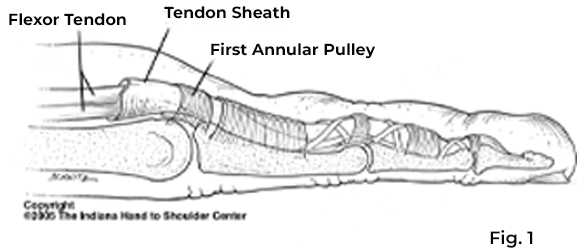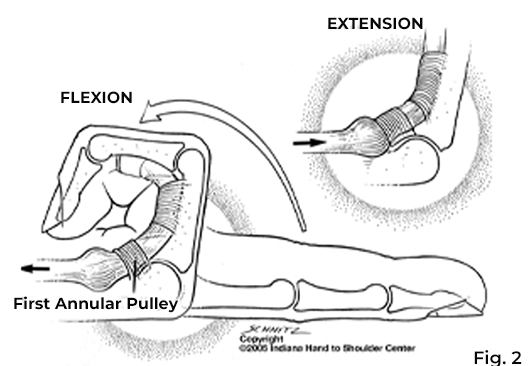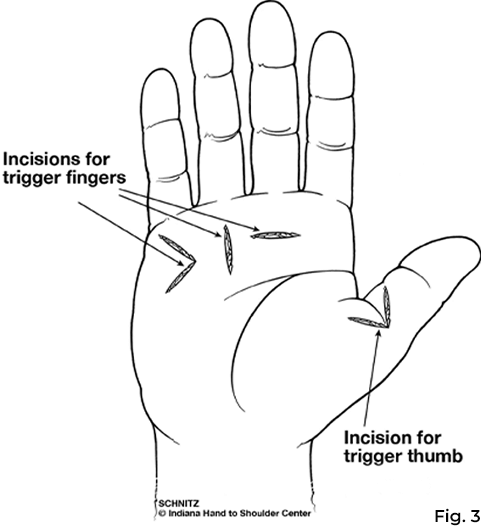What Is Trigger Finger?
In old western movies, you may have heard the term “trigger finger,” but what is trigger finger in the medical field?

Trigger finger is a common hand disorder that can cause pain, snapping, or locking of the fingers or thumb. The sensation of locking or catching has often been referred to as triggering.
Tendons in the hand are strong cords that connect the muscle of the forearm to the bones of the fingers and thumb, allowing them to bend the digits into a fist and straighten. Tendons are covered with a thin layer of tissue called tenosynovium, which helps them glide through a protective tunnel called the tendon sheath. (Fig. 1)
Certain areas of the tendon sheath are thickened, forming specialized bands called pulleys which hold the tendon next to the bone, much like the eyes of a fishing rod hold the line near the rod.
Thickening of the tenosynovium or the tendon itself prevents it from gliding freely within the tendon sheath. When the normal smooth gliding property of the tendon is lost, the digit becomes painful.

As the tendon becomes larger, it can either become stuck entirely inside the sheath preventing flexion of the digit into a fist or blocked from entering the sheath, which may make it impossible to straighten the digit. (Fig. 2)
This is often experienced by patients with what is trigger finger on awakening. It may require them to use their other hand to pull the finger into a straightened position.
What Are the Causes?
Several factors can lead to the thickening of the tendon or its tenosynovium. These include grasping or weight bearing on the hand, as when using a cane or crutches is required, as well as prolonged gripping with hand tools. Medical conditions like diabetes, gout, and inflammatory disease may contribute to this thickening.
Treatments for What Is Trigger Finger
When the finger or thumb is painful or triggering, the initial treatment reduces the amount of thickening present in the tendon or tenosynovium. This may include wearing a splint at night, using anti-inflammatory medications, or injecting a cortisone preparation into the tendon sheath. These conservative measures usually reduce pain and triggering over a few weeks.
In cases where a patient has chronic symptoms or a completely locked, painful, and immovable digit, surgery may be recommended in place of nonoperative measures.
If Surgery Is Necessary

Surgery is performed to enlarge the tendon sheath at its leading edge, which allows the tendon to glide without locking or catching again. A small incision is made in the palm in line with the affected digit. (Fig. 3) Once the tendon sheath has been enlarged, the patient is often asked to move their finger to confirm that triggering no longer exists.
Following the surgery, a light dressing is placed over the sutures. You should perform movement of the affected digit several times a day to allow for recovery of normal motion. Recurrences of triggering are quite rare.
No part of this work may be reproduced without written permission from the Indiana Hand to Shoulder Center.
Disclaimer: The materials on this website have been prepared for informational purposes only and do not constitute advice. You should not act or rely upon any medical information on this website without a physician’s advice. The information contained within this website is not intended to serve as a substitution for a thorough examination from a qualified healthcare provider. The display of this information is not intended to create a health care provider-patient relationship between the Indiana Hand to Shoulder Center and you.
Trigger Finger Patient Handout
